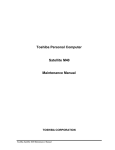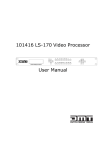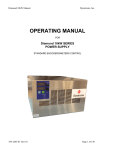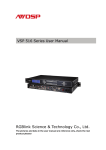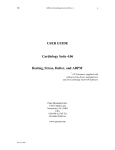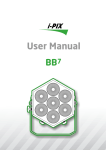Download Black Box twister 7000 User guide
Transcript
JULY 1999 LE7402C-TX LH7402C-TX-R2 LH7403C-MMSC-R2 LH7404C-SMSC-R2 LH7403C-MMST-R2 LH7403C-SMST-R2 MEDIA CONVERTER 7000 ™ “redundant twister” MODULES 100 BASE 10 BASE RESET PWR SW RESET LK M A I N PWR SW RESET LK P R I AT AT LK LK S E C MAIN AT LK P R I S E C AT 100 BASE “redundant twister” LK M A I N AT 100 BASE “redundant twister” AT LK PWR SW AT SW SECONDARY R X T X MAIN PWR RESET AT R X T X AT SECONDARY PRIMARY LK LK LK AT R X T X PRIMARY LK AT R X T X LK AT SEC SEC Installation & User Guide CUSTOMER SUPPORT INFORMATION Order toll-free in the U.S. 24 hours, 7 A.M. Monday to midnight Friday: 877-877-BBOX FREE technical support, 24 hours a day, 7 days a week: Call 724-746-5500 or fax 724-746-0746 Mail order: Black Box Corporation, 1000 Park Drive, Lawrence, PA 15055-1018 Web site: www.blackbox.com • E-mail: [email protected] © 1999 Black Box Corporation All rights reserved. Printed in USA. Black Box and the Black Box logo are registered trademarks of Black Box Corporation. All other trademarks appearing in this manual are the property of their owners. This publication is protected by the copyright laws of the United States and other countries, with all rights reserved. No part of this publication may be reproduced, stored in a retrieval system, translated, transcribed, or transmitted, in any form, or by any means manual, electric, electronic, electromagnetic, mechanical, chemical, optical or otherwise, without prior explicit written permission of Black Box Corporation. The information contained in this document is assumed to be correct and current. The manufacturer is not responsible for errors or omissions and reserves the right to change specifications at any time without notice. Table of Contents Media Converter 7000 “redundant twister” Module Installation & User Guide Product Overview ....................................................................................... 4 Installation Guide ...................................................................................... 7 STEP 1: Unpacking the “redundant twister” Module ................... 7 STEP 2: Setting the DIP Switches ............................................... 7 STEP 3: Setting the MDI-II/MDI-X Switch ............................... 10 STEP 4: Installing the “redundant twister” Module .................... 12 STEP 5: Connecting to the Network .......................................... 13 User Guide ............................................................................................... 15 Module LED Operation ............................................................ 15 Reset Push Button .................................................................... 16 Link Loss Carry Forward (LLCF) ............................................ 17 Topology Solutions .................................................................. 18 Technical Specifications ........................................................... 19 Product Safety, EMC and Compliance Statements .................. 21 Overview The Media Converter 7000 “redundant twister” Module offers the resiliency of data link redundancy to ensure network integrity with no down time. This link duplication provides the non-stop networking capability essential for high priority traffic and mission-critical applications. The “redundant twister” modules provide full redundant data paths for Ethernet or Fast Ethernet devices. The Fast Ethernet “redundant twister” modules also provide 100BASE-TX to FX media conversion. In Dynamic Revovery Mode (DRM) the “redundant twister” module actively monitors the primary link and if it fails, automatically activates the secondary link without interruption to network operation. The “redundant twister” modules have the following features: • Can be configured to operate in Dynamic Recovery Mode (DRM) to ensure session integrity and increased uptime. • Can be configured to operate in Network Select Mode (NSM) to redirect and isolate traffic adding extra security. • Immediately switches over from the primary link to the secondary link if the primary link fails. • Can be configured to return automatically to the primary link after the failure condition is resolved or only upon secondary failure; or manually switched back to primary after fail-over. • In addition to providing link and data on the active ports, the “redundant twister” module can be configured to provide link or link and redundant transmit data on the non-active port. • Provides minimal impact on the round trip delay for communication in half duplex collision domains. • Fast Ethernet modules demonstrate a maximum loss of 2-3 packets (measured with minimum packet size and minimum inter-packet gap) during fail-over transition. • Supports full and half-duplex operation. • Link Loss Carry Forward* enable/disable functionality. * Please refer to the page titled “Link Loss Carry Forward (LLCF)” in the User Guide section of this document for more detailed information. 4 • All twisted-pair ports are equipped with an MDI-II to MDI-X switch eliminating the need for crossover cables. • Auto-polarity support on all twisted-pair ports. • Functions with devices configured for auto-negotiation (parallel detection). • Fused power on each module protects the system from a short circuit on a module. This prevents a faulty module from bringing down the entire system. The “redundant twister” module is available in six models and can be installed in any Media Converter 7000 chassis. These models each contain a MAIN port, a PRIMARY port and a SECONDARY port. Redundancy is provided between the PRIMARY and SECONDARY ports. Because of the size of the “redundant twister” fiber optic modules, each TX-FX module uses two slots in the chassis. The TX-TX modules use only one slot. Model Number Mbps Connectors ________________ Maximum Supported Link Length LE7402C-TX LH7402C-TX-R2 LH7403C-MMSC-R2 LH7404C-SMSC-R2 LH7403C-MMST-R2 LH7403C-SMST-R2 10 BASE RESET PWR SW LK M A I N AT 10 100 100 100 100 100 RJ-45 to redundant RJ-45 ____________ 100m/100m RJ-45 to redundant RJ-45 ____________ 100m/100m RJ-45 to redundant FX multimode SC ____ 100m/2km RJ-45 to redundant FX singlemode SC __ 100m/15km RJ-45 to redundant FX multimode ST ____ 100m/2km RJ-45 to redundant FX singlemode ST __ 100m/15km 100 BASE RESET PWR SW M A I N AT RESET LK P R I AT LK LK S E C AT SEC 100 BASE “redundant twister” MAIN AT LK P R I 100 BASE “redundant twister” LK S E C AT LK PWR SW AT SW SECONDARY R X T X MAIN PWR RESET AT R X T X AT SECONDARY PRIMARY LK LK LK AT R X T X PRIMARY LK AT R X T X LK AT SEC LE7402C-TX LH7402C-TX-R2 LH7403C-MMSC-R2 LH7403C-MMST-R2 LH7404C-SMSC-R2 LH7403C-SMST-R2 Media Converter 7000 “redundant twister” Modules 5 6 Installation Guide Installation Guide Follow the simple steps outlined in this section of the manual to install and start using your “redundant twister” Module. 1 Unpack the “redundant twister” Module. Check that the following components have been included with your order: • “redundant twister” Module Your order has been provided with the safest possible packaging, but shipping damage does occasionally occur. Inspect your order carefully for damage that may have occurred during shipment. If you discover any shipping damage, notify the carrier and follow their instructions for damage and claims. Save the original shipping carton in case return or storage of the unit is necessary. RED LLCF LINK AUTO TX NOTE: When setting the DIP switches, the UP position is when the lever of the DIP switch is pushed furthest away from the circuit board. The DOWN position is when the lever of the DIP switch is pushed closest to the printed circuit board. 1 2 3 4 5 2 Set the DIP Switches. A set of 5 DIP switches, located on the module board, provide user-selectable configurability options for several modes of operation. These switches are clearly marked on the module’s printed circuit board. Refer to the table on the next page for the proper setting of the DIP switches.* DOWN UP Media Converter 7000 “redundant twister” Modules 7 The DIP switches are marked on the printed circuit board and can be set for the following operational functions: Switch Name TX AUTO LINK LLCF Position* Operation UP Data transmits on both the PRIMARY and SECONDARY ports simultaneously. Link on both must be enabled. DOWN (default) Data transmits on the active port only. UP Active port automatically reverts back to the PRIMARY port when the primary link is re-established. DOWN (default) Active port will not revert back to the PRIMARY port when a primary link is re-established until the SECONDARY link fails. If the SECONDARY link does not fail, the SECONDARY port remains active. Use the RESET push button located on the front of the module to force the active port back to the PRIMARY port and clear the SW LED. UP Link symbols are sent out on both the PRIMARY and SECONDARY ports (i.e. Link is sent out both ports). DOWN (default) Link symbols are sent out on the active port only. With the LINK switch in this position, data is not transmitted out the non-active port regardless of the TX switch setting. UP Link Loss Carry Forward is enabled. DOWN (default) Link Loss Carry Forward is disabled. * When setting the DIP switches, the UP position is when the lever of the DIP switch is pushed furthest away from the circuit board. The DOWN position is when the lever of the DIP switch is pushed closest to the printed circuit board. 8 Installation Guide RED UP Operates in Dynamic Recovery Mode (DRM). (default) If the PRIMARY link fails, the SECONDARY port becomes active. Refer to the description of the AUTO switch. DOWN Operates in Network Select Mode (NSM). Use the RESET push button to toggle between PRIMARY and SECONDARY. In NSM, the AUTO switch sets the initial active port on power up. Up is SECONDARY and down is PRIMARY. Note that the SW LED remains off in the Network Select Mode. RED LLCF LINK AUTO TX 1 2 3 4 5 DIP Switches RJ-45 RJ-45 RJ-45 RED LLCF LINK AUTO TX 1 2 3 4 5 DIP Switches RJ-45 FX SC (ST) FX SC (ST) Media Converter 7000 “redundant twister” Modules 9 3 Set the MDI-II/MDI-X Switch. For every twisted-pair port, a switch is used to implement the transmit and receive crossover functionality. The switch is positioned just behind its associated RJ-45 connector. On TX-FX modules, the switch is hidden from direct view by the smaller daughter circuit board. Use a small paperclip for easy access. Refer to the illustration below for the location of the MDI-II/MDI-X switch(es): RED LLCF LINK AUTO TX 1 2 3 4 5 MDI-X Position DIP Switches Slide Switches RJ-45 RJ-45 RJ-45 MDI-II Position (default) MDI-X Position Slide Switch RJ-45 FX SC (ST) RED LLCF LINK AUTO TX 1 2 3 4 5 MDI-II Position (default) DIP Switches FX SC (ST) smaller daughter circuit board 10 Installation Guide The switch connects the transmit and receive signal pairs in either straight through or crossover configurations. The signal routing is as follows: Switch Position Connection TX+ to TX+ TX- to TXRX+ to RX+ RX- to RXTX+ to RX+ TX- to RXRX+ to TX+ RX- to TX- When setting the MDI-II/MDI-X switch, observe the positioning of the following symbols: • the parallel symbol (II) indicates a straight through or parallel connection (default) • the cross symbol (X) indicates a crossover connection. These two symbols are clearly marked on the printed circuit board. Simply slide the switch in the direction of the appropriate symbol. Because of the smaller space between boards on TX-FX modules, use a paperclip to reach in and push or pull the switch toward the appropriate symbol. Media Converter 7000 “redundant twister” Modules 11 4 Install the “redundant twister” Module. “redundant twister” modules offer the ease of plug-and-play installation and are hot-swappable. All modules must be firmly secured to the chassis before network connections are made. Follow the simple steps outlined below to install the “redundant twister” module: NOTE: Each TX-FX module uses two slots in the chassis. The TX-TX module uses only one. • Grasp the module by the front panel as shown. Card Guide 100 BASE 10 BASE PWR 10 BASE PWR 100 BASE PWR 100 BASE 100 BASE PWR PWR 100 BASE 100 BASE PWR 100 BASE “redundant twister” PWR 10 BASE PWR “redundant twister” SW RESET SW TP TP LK LK M A I N AT AT LK P R I AT M M LK AT R X M M T X TX LK R X COL T X TX LK AT AT AT R X S M T X LK AT R X S M T X PWR AT RESET LK AT R X T X SECONDARY FX LK AT R X T X LK AT R X T X SW RESET PRIMARY LK R X AT T X LK LK R X AT T X AT I “redundant twister” N SECONDARY LK 100 BASE A AT PRIMARY LK R X AT T RESET X PWR SW SECONDARY SEC R X M M T X IMPORTANT! Tighten thumb screw to secure each module firmly to chassis before making network connections. RESET MAIN LK SW AT FX LK MAIN PWR LK M FL BNC LK AT R X T X AT S E C LK LK P LK AT MAINR LK AT S AT E C LK I DISCONNECT ALL POWER SOURCES BEFORE SERVICING AC IN 100-240V 50/60Hz 2A DISCONNECT ALL POWER SOURCES BEFORE SERVICING AC IN 100-240V 50/60Hz 2A AT PRIMARY LK R X AT MM T X LK SEC AT Thumb Screw Blank Panel Card Guide • Insert the module into a slot on the chassis making sure that the top and bottom edges of the main module board are aligned with the top and bottom card guides in the chassis. Do not force the module into the chassis unnecessarily. It should slide in easily and evenly. • Slide the module in until the top and bottom edges of the front panel are flush and even with the top and bottom edges of the chassis. • Turn the thumbscrew clockwise until it is snug to secure the module to the chassis. • The “redundant twister” module is now properly installed and ready for connection to the network. 12 Installation Guide 5 Connect to the Network. A total of three connections must be made on the front panel when connecting the “redundant twister” module to the network. Be sure that all modules are firmly secured to the chassis before making network connections. • Connect to the MAIN port. Each “redundant twister” module provides one shielded RJ-45 jack for 10BASE-T/100BASE-TX connections and supports a maximum segment length of 100 meters over Category 3, 4 or 5 Twisted-pair Cable for 10Mbps and Category 5 Twisted-pair Cable for 100Mbps. Refer to STEP 3 for MDI-II to MDI-X switch functionality. Before making the proper twisted-pair connection, you must verify the port configuration of the connected device. Embedded Parallel Function Device with Straight Through TP Port Configuration 1 2 3 6 “redundant twister” TP Port Configuration TD+ TDRD+ RD- TD+ TDRD+ RD- 1 2 3 6 Embedded Crossover Function “redundant twister” TP Port Configuration 1 2 3 6 MDI TD+ TDRD+ RD- Typical Hub TP Port Configuration MDI–X TD+ TDRD+ RD- 1 2 3 6 A device that is wired straight through, needs one crossover connection: If the cable is… … the MDI-II to MDI-X Switch Setting should be straight through X crossover II A device that is wired crossover, needs a parallel connection: If the cable is… … the MDI-II to MDI-X Switch Setting should be straight through II crossover X If you do not know the internal wiring configuration of the other device’s RJ-45 port, consult the product documentation. • Connect to the PRIMARY port. • Connect to the SECONDARY port. The LE7402C-TX and LH7402C-TX-R2 “redundant twister” modules provide two additional RJ-45 jacks for 10BASE-T/100BASE-TX connections and supports a maximum segment length of 100 meters over Category 3, 4 or 5 Twisted-pair Cable for 10Mbps and Category 5 Twisted-pair Cable for 100Mbps. Media Converter 7000 “redundant twister” Modules 13 The LH7403C-MMSC-R2 and LH7403C-MMST-R2 “redundant twister” modules provide two sets of 100BASE-FX multimode SC or ST connectors that support a maximum segment length of up to 2km. The LH7404C-SMSC-R2 and LH7403C-SMST-R2 “redundant twister” modules provide two sets of 100BASE-FX singlemode SC or ST connectors that suppport a maximum segment length of up to 15km. When making fiber optic connections, be sure that the transmit (TX) optical conductor of the “redundant twister” module connects to the receive (RX) optical conductor of the connected device; and be sure that the transmit (TX) optical conductor of the device connects to the receive (RX) optical conductor of the “redundant twister” module for both the PRIMARY and SECONDARY links. Use the Link (LK) LEDs on the front panel of the module to verify correct segment connectivity. As you insert the cable into each port, the LK LED illuminates provided there is power being applied to the chassis and that there is an active device connected to the other end of the cable sending idle link symbols. 100 BASE 100 BASE PWR 100 BASE 100 BASE PWR 100 BASE “redundant twister” PWR 100 BASE LK AT R X M M T X AT FX R X T X LK AT R X S M T X MAIN LK AT AT P R I AT R X AT T X PWR AT RESET SECONDARY RESET MAIN LK SW LK LK S E C SEC 14 PWR LK M A I N PWR SW RESET LK 100 BASE PWR “redundant twister” SW TX LK SW AT LK P R I RESET PRIMARY LK R X AT T X SECONDARY LK R X AT T X PRIMARY LK R X AT T X AT AT LK AT LK S E C AT SEC 10 BASE PWR SW RESET MAIN LK M A I N 100 BASE “redundant twister” SW RESET PWR LK M A I N AT P R I AT R X LK P R I T X PRIMARY LK R X AT T X LK AT M A I N RESET SECONDARY AT SEC SW LK LK S E C LK AT AT LK AT LK S E C AT SEC DISCONNECT ALL POWER SOURCES BEFORE SERVICING AC IN 100-240V 50/60Hz 2A DISCONNECT ALL POWER SOURCES BEFORE SERVICING AC IN 100-240V 50/60Hz 2A User Guide This section contains more detailed user information regarding the operating features of your “redundant twister” module. Module LED Operation Several LEDs are visible from the front panel. These include SW, PWR, SECONDARY, LK and AT LEDs. There are separate LK and AT LEDs for each of the three ports (MAIN, PRIMARY and SECONDARY). Refer to the table below for a description of each: The function of each LED is as follows: LED Label Color (Status) Indication SW Amber (steady) SECONDARY port was the active port at some point. This LED functions in Dynamic Recovery Mode (DRM) only. PWR Green (steady) Power ON SECONDARY Green (steady) ON SECONDARY active OFF PRIMARY active (MAIN) LK Green (steady) Receive link present (MAIN) AT Green (blinking) Receiving data (PRIMARY) LK Green (steady) Receive link present (PRIMARY) AT Green (blinking) Receiving data (SECONDARY) LK Green (steady) Receive link present (SECONDARY) AT Green (blinking) Receiving data Media Converter 7000 “redundant twister” Modules 15 Reset Push Button A small RESET push button is located on the front panel of the “redundant twister” Module. When used in conjunction with the module’s SW and SECONDARY LEDs, and the AUTO DIP switch setting, this push button allows a network administrator to effectively maintain or troubleshoot a PRIMARY link connection. Because of its small size and recessed placement within the front panel, press the RESET push button with the tip of a pointed object. Pushing and holding the RESET push button has no effect. It is the act of pressing the push button that causes a reset. In the event of a PRIMARY link failure, pressing the RESET push button has the following effect: If the AUTO switch is UP and RED switch is UP The active port automatically reverts to PRIMARY when primary link is re-established and pressing the RESET switch clears the SW LED. If the AUTO switch is DOWN and RED switch is UP The active port does not automatically revert to PRIMARY when a primary link is re-established. Pressing the RESET switch clears the SW LED and the SECONDARY LED and forces the PRIMARY port to be the active port. If the SECONDARY link is disabled, it reverts to the PRIMARY if the PRIMARY has a good link. If there is only a SECONDARY link, then the SW and SECONDARY LEDs remain illuminated and pressing the RESET switch has no effect. If the RED switch is DOWN 16 User Guide The module operates in Network Select Mode (NSM). The RESET push button toggles the active link between the PRIMARY and SECONDARY ports. Note that the SW LED remains off during Network Select Mode (NSM) operation. Link Loss Carry Forward (LLCF) The “redundant twister” Modules have been designed with an LLCF function for troubleshooting a remote connection. The modules are shipped with the LLCF disabled. When LLCF is enabled, the fiber optic ports as well as the twisted-pair ports on the module do not transmit a link signal until they receive a link signal from the opposite port. For example, if LLCF is enabled and two “redundant twister” Modules are connected via a fiber cable with nothing else connected to them, the Link LED does not illuminate. When a valid link is established at the twisted-pair port, a complete connection is accomplished. The diagram below shows a typical network configuration using a “redundant twister” Module for remote connectivity: Management Switch/Hub Station w/SNMP “twister” 7000 Module “twister” 7000 Module Switch/Hub Management w/SNMP Station Remote up to 40km LED lit = established link LED unlit = no link If the fiber connection breaks, or the remote device fails, the “redundant twister” Module carries that link loss all the way to the switch/hub which generates a trap to the management station. The administrator can then look at the module to determine the source of the loss. Management Switch/Hub Station w/SNMP “twister” 7000 Module “twister” 7000 Module Switch/Hub Management w/SNMP Station Broken Remote Cable Link Loss Carried LED lit = established link LED unlit = no link IMPORTANT: When connecting a “redundant twister” Module to a port that supports auto-negotiation, it is strongly recommended to fix the port setting to the appropriate speed (100Mbps or 10Mbps) and to either full or half-duplex. This allows the “redundant twister” Module to sense receive link and select the active port. Media Converter 7000 “redundant twister” Modules 17 Topology Solution Server Cluster “A” Server Cluster “B” Servers with 100Mbps NICs “twister” Media Converter 7000 with “redundant twister” Modules Secondary F/O Link “B” Primary F/O Link “A” Secondary F/O Link “A” Primary F/O Link “B” 100Mbps F/O Switch Enterprise Switch 18 User Guide 100Mbps F/O Switch Technical Specifications Data Rate LE7402C Half-duplex ________________________________ 10Mbps Full-duplex _________________________________ 20Mbps LH740XC Half-duplex _______________________________ 100Mbps Full-duplex ________________________________ 200Mbps 10Mbps Twisted-Pair Interface Connector _____________________________ Shielded RJ-45, 8-pin jack Impedance ___________________________________ 100 Ohms nominal Signal Level Output (differential) _______________________ 2.2 to 2.8V Signal Level Input ________________________________ .3 to 3.1V p-p Supported Link Length ____________________________________ 100m Cable Type ______________________________ Category 3, 4, or 5 UTP 100Mbps Twisted-Pair Interface Connector _____________________________ Shielded RJ-45, 8-pin jack Impedence ___________________________________ 100 Ohms nominal Signal Level Output (differential) ______________________ .95 to 1.05V Signal Level Input _____________________________ 350mV minimum Supported Link Length ____________________________________ 100m Cable Type ____________________________________ Category 5 UTP 100Mbps Multimode Fiber Optic Interface Connector ___________________________________________ ST or SC RX Input Sensitivity _______________________ -31 dBm peak minimum Output Power ___________________ -14 dBm to -23.5 dBm (50/125 µm) ______________________ -14 dBm to -20 dBm (62.5/125 µm) Supported Link Length _______________________ up to 2km full duplex Cable Type ______________________ 50/125, 62.5/125, 100/140 µm F/O 100Mbps Singlemode Fiber Optic Interface Connector ___________________________________________ ST or SC RX Input Sensitivity _______________________ -31 dBm peak minimum Output Power ______________________ -8 dBm to -15 dBm (9/125 µm) Supported Link Length ______________________ up to 15km full duplex Cable Type __________________ 8.3/125, 8.7/125, 9/125, 10/125 µm F/O Media Converter 7000 “redundant twister” Modules 19 Power Requirements LE7402C-TX _____________________________________ .5Amps max. LH7402C-TX-R2 ____________________ 5 VDC @ 0.750Amps, 3.75W LH740XC _____________________________ 5 VDC @ 1.3Amps, 6.5W Environmental Operating Temperature _________________________________ 0 – 50° C Storage Temperature _________________________________ -30 – 70° C Operating Humidity _____________________ 5% – 95% non-condensing Weight _______________________________________________ 5 oz. 20 User Guide Product Safety, EMC and Compliance Statements This equipment complies with the following requirements: • UL • CSA • EN60950 (safety) • FCC Part 15, Class A • EN55022 Class A (emissions) • EN50082-1 (immunity) • IEEE 802.3/802.3u • IEC 825-1 Classification Class 1 Laser Product Radio Frequency Interference Statements FCC Radio Frequency Interference Statement This equipment has been tested and found to comply with the limits for Class A digital device, pursuant to Part 15 of FCC Rules. These limits are designed to provide reasonable protection against harmful interference when the equipment is operated in a commercial environment. This equipment generates, uses and can radiate radio frequency energy, and if not installed and used in accordance with the instruction manual, may cause harmful interference to radio communication. Operation of this equipment in a residential area is likely to cause harmful interference in which case the user will be required to correct the interference at his own expense. CAUTION: Changes or modifications to this equipment not expressly approved by the party responsible for compliance could void the user’s authority to operate the equipment. Canadian Radio Frequency Interference Statement This Class A digital apparatus meets all requirements of the Canadian Interference-Causing Equipment Regulations. Cet appareil numérique de la classe A respecte toutes les exigences du Règlement sur le matériel brouilleur du Canada. Media Converter 7000 “redundant twister” Modules 21 Electrical Safety Statement Normas Oficiales Mexicanas (NOM) INSTRUCCIONES DE SEGURIDAD 1. Todas las instrucciones de seguridad y operación deberán ser leídas antes de que el aparato eléctrico sea operado. 2. Las instrucciones de seguridad y operación deberán ser guardadas para referencia futura. 3. Todas las advertencias en el aparato eléctrico y en sus instrucciones de operación deben ser respetadas. 4. Todas las instrucciones de operación y uso deben ser seguidas. 5. El aparato eléctrico no deberá ser usado cerca del agua—por ejemplo, cerca de la tina de baño, lavabo, sótano mojado o cerca de una alberca, etc. 6. El aparato eléctrico debe ser usado únicamente con carritos o pedestales que sean recomendados por el fabricante. 7. El aparato eléctrico debe ser montado a la pared o al techo sólo como sea recomendado por el fabricante. 8. Servicio—El usuario no debe intentar dar servicio al equipo eléctrico más allá a lo descrito en las instrucciones de operación. Todo otro servicio deberá ser referido a personal de servicio calificado. 9. El aparato eléctrico debe ser situado de tal manera que su posición no interfiera su uso. La colocación del aparato eléctrico sobre una cama, sofá, alfombra o superficie similar puede bloquea la ventilación, no se debe colocar en libreros o gabinetes que impidan el flujo de aire por los orificios de ventilación. 10. El equipo eléctrico deber ser situado fuera del alcance de fuentes de calor como radiadores, registros de calor, estufas u otros aparatos (incluyendo amplificadores) que producen calor. 22 11. El aparato eléctrico deberá ser connectado a una fuente de poder sólo del tipo descrito en el instructivo de operación, o como se indique en el aparato. 12. Precaución debe ser tomada de tal manera que la tierra fisica y la polarización del equipo no sea eliminada. 13. Los cables de la fuente de poder deben ser guiados de tal manera que no sean pisados ni pellizcados por objetos colocados sobre o contra ellos, poniendo particular atención a los contactos y receptáculos donde salen del aparato. 14. El equipo eléctrico debe ser limpiado únicamente de acuerdo a las recomendaciones del fabricante. 15. En caso de existir, una antena externa deberá ser localizada lejos de las lineas de energia. 16. El cable de corriente deberá ser desconectado del cuando el equipo no sea usado por un largo periodo de tiempo. 17. Cuidado debe ser tomado de tal manera que objectos liquidos no sean derramados sobre la cubierta u orificios de ventilación. 18. Servicio por personal calificado deberá ser provisto cuando: A: El cable de poder o el contacto ha sido dañado; u B: Objectos han caído o líquido ha sido derramado dentro del aparato; o C: El aparato ha sido expuesto a la lluvia; o D: El aparato parece no operar normalmente o muestra un cambio en su desempeño; o E: El aparato ha sido tirado o su cubierta ha sido dañada. Media Converter 7000 “redundant twister” Modules 23 © Copyright 1999. Black Box Corporation. All rights reserved. 1000 Park Drive • Lawrence, PA 15055-1018 • 724-746-5500 • Fax 724-746-0746 5660-771111-002 A 7/99

























